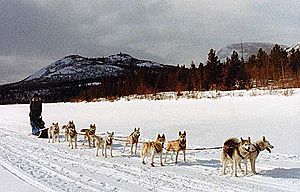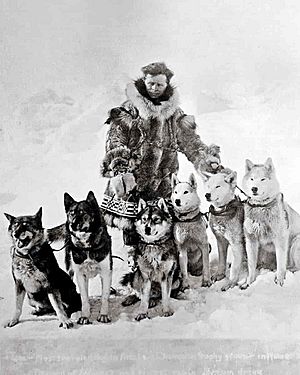Leonhard Seppala facts for kids
Quick facts for kids
Leonhard Seppala
|
|
|---|---|

Leonhard Seppala after the 1925 serum run
|
|
| Born | September 14, 1877 Lyngen, Troms og Finnmark, Norway
|
| Died | January 28, 1967 (aged 89) Seattle, Washington, U.S.
|
| Occupation | Sled dog breeder, racer |
| Known for | 1925 serum run to Nome |
| Spouse(s) | Constance Seppala |
| Children | 1 |
Leonhard Seppala (born September 14, 1877 – died January 28, 1967) was a famous sled dog breeder, trainer, and driver. He was Norwegian-American. Leonhard Seppala and his amazing dogs were very important in the 1925 serum run to Nome. This was a race against time to deliver medicine. He also took part in the 1932 Winter Olympics. Seppala helped introduce the Siberian Husky dog breed to America. Today, an award for excellent sled dog care, the Leonhard Seppala Humanitarian Award, is named after him.
Contents
Early Life and Moving to Alaska
Leonhard Seppala was born in Lyngen, a place in northern Norway. His family later moved to the island of Skjervøya. His father worked as a blacksmith and a fisherman. Leonhard first followed in his father's footsteps.
In 1900, Leonhard moved to Alaska. He went there during the Nome gold rush. His friend, Jafet Lindeberg, convinced him to work for his mining company in Nome. Leonhard became a citizen of the United States in 1906.
Becoming a Dog Sled Driver
During his first winter in Alaska, Leonhard became a dog sled driver for Lindeberg's company. He loved driving the sled from his very first trip. He enjoyed the sound of the dogs' feet and the feeling of the sled moving smoothly on the snow.
Most drivers thought a 30-mile (48 km) run was long. But Seppala often traveled between 50 miles (80 km) and 100 miles (160 km) each day. This meant he worked up to 12 hours a day. He kept his dogs strong in the summer by having them pull a cart with wheels. At that time, it was unusual to keep sled dogs working when the snow melted. It was also unusual to spend as much time with them as Seppala did.
Racing Sled Dogs
In 1913, Leonhard Seppala got his first team of sled dogs by chance. His friend, Jafet Lindeberg, had brought the puppies from Siberia. They were meant to be a gift for explorer Roald Amundsen. Amundsen planned to use them for an expedition to the North Pole.
Seppala was asked to train these dogs. He said, "I literally fell in love with them from the start." He could not wait for the snow to start their training. Amundsen later canceled his trip. So, Lindeberg gave the dogs to Seppala.
First Race and Challenges
Seppala decided to enter his first race, the 1914 All Alaska Sweepstakes, at the last minute. He and his lead dog, Suggen, did not know the dangerous trail. A sudden snowstorm hit during the race. Seppala realized his young dogs had lost the trail. They were all in danger of falling off a cliff near the Bering Sea.
When the storm cleared, Seppala saw they were at the bottom of a hill. They were racing toward the cliffs. Luckily, he stopped just 20 feet (6 meters) from the edge. This saved their lives. However, many of his dogs' paw pads were cut. Their claws were broken by the icy snow as they climbed back up the hill. Some also got frostbite. Seppala felt bad for putting his loyal dogs in danger. He quit the race because he was ashamed. He spent most of that year helping his dogs heal. They were ready to train again in the autumn.
Winning Races
Seppala's racing career really took off the next year. In the 1915 All Alaska Sweepstakes, he had a close race with experienced musher Scotty Allan. Seppala beat him on the fourth day. He finished two hours ahead of Allan to win the race. He then won the race for the next two years as well. After that, the All Alaska Sweepstakes race was stopped until 1983.
The "Great Race of Mercy" of 1925
In the winter of 1925, a serious illness called diphtheria spread in Seppala's town of Nome, Alaska. Children and adults who had not been exposed to the illness were at risk of dying. Seppala's own eight-year-old daughter, Sigrid, was also in danger.
The only medicine available was diphtheria antitoxin serum. But Nome's supply was not enough. Also, it was past its expiry date and might not work. Without the medicine, almost everyone who got sick would die. The only way to get more medicine to Nome was by dog sled. This was because it was the coldest winter in 20 years.
A relay team of skilled mushers was put together to deliver the medicine quickly. Seppala and his lead dog, Togo, were chosen for the most difficult part of the trail. The medicine was sent by train to Nenana. From there, dog sled teams would travel from Nome and Nenana. They would meet in the middle at Nulato. The whole trail was 674 miles (1,085 km) long. Seppala was first chosen to cover over 400 miles (640 km) from Nome to Nulato and back.
A Dangerous Shortcut
Seppala's part of the trail included a risky shortcut across Norton Sound. This shortcut could save a whole day of travel. It was decided that he was the best musher to try this shortcut. The ice on Norton Sound was always moving because of ocean currents and strong winds. The ice could be rough hills or slippery "glare ice" where dogs struggled to get a grip. Small cracks in the ice could suddenly get wider. This could cause the driver and team to fall into the freezing water.
If the wind blew from the east, it could be very fast. It could flip sleds over and push dogs off course. A strong east wind could also push the ice out to sea. A team caught on a drifting piece of ice could be stuck on open water. Seppala had taken this shortcut many times before. A less experienced musher would likely lose their life, their dogs, and the needed medicine. Seppala would cross the sound both ways during the race to deliver the medicine.
The Race Against Time
Seppala left Nome on January 28. This was several days before he was supposed to meet the relay team coming to Nulato. He crossed Norton Sound safely. Meanwhile, more people in Nome were getting sick with diphtheria. To speed up the delivery, more mushers were added to the relay. But it was too late to tell Seppala that he would meet the relay closer to Nome.
After 3 days and 170 miles (270 km), he saw another musher, Henry Ivanoff. But Seppala did not realize it was him. Seppala saw the musher stopped and having trouble with his dogs. He did not want to stop and be delayed. Ivanoff had to run after Seppala, shouting, "The serum! The serum! I have it here!"
When Seppala got the medicine, night was falling. A powerful storm was moving towards the trail. Seppala had to decide whether to risk crossing Norton Sound in high winds and darkness. He could not see or hear warning signs from the ice. But going around the ice would delay the medicine by a full day. So, he chose to go across. As he raced to the roadhouse at Isaac's Point on the other side, strong winds made the cold feel much worse. When he arrived at 8 p.m., his dogs were very tired. They had run 84 miles (135 km) that day, much of it against the wind and in extreme cold. They could only rest for a short time. They set out again at 2 a.m.
The next day, the storm had become a severe blizzard. There was blinding snow and winds of at least 65 mph (105 km/h). Seppala continued across Norton Sound. This avoided rocky cliffs along the shore. But it also put him and his team in danger on the Sound. Conditions on the ice were very risky. There were sudden soft spots in the ice and open water sometimes only a few feet away. Just a few hours after they crossed it, the ice broke up completely and drifted out to sea.
With Norton Sound behind them, Seppala and his team faced the last big challenge. They had to climb an 8-mile (13 km) ridge to the top of Little McKinley. The trail here was open and very steep. This was very hard for the dogs. They were tired and had already raced 260 miles (420 km) over the past 4.5 days. However, at 3 p.m. that day, Seppala and his team reached Golovin. He handed the medicine to the next musher. The medicine was now only 78 miles (126 km) from Nome. It arrived there the next day, Monday, February 2, at about 5:30 a.m. It was ready to be used by 11 a.m.
This emergency delivery is also known as the "Great Race of Mercy." It is remembered every year with the Iditarod Trail Sled Dog Race.
Life After the Serum Run
After the Serum Run, Seppala and about 40 of his dogs toured the United States. His tour ended in January 1927 with a dogsled race in Poland Spring, Maine. There, he raced against Arthur Treadwell Walden, who owned a famous lead dog named "Chinook." Even with some problems on the trail, Seppala won the race. He beat the bigger, slower dogs driven by Walden.
The excitement for sled dog racing in New England, along with the fame from the Serum Run and his victory, helped Seppala and his partner Elizabeth Ricker start a Siberian dog kennel in Poland Spring. This was how the Siberian Husky breed began to spread in the United States and Canada. He bred Togo, and Togo's descendants helped create the "Seppala Siberian Sleddog" line. This line of dogs is still sought after for sledding.

In 1928, Seppala moved his home to near Fairbanks, Alaska. In 1931, his partnership with Elizabeth Ricker ended. Sled dog racing was a special event at the Lake Placid Winter Olympic Games in 1932. Seppala won a silver medal in this event.
In 1946, Leonhard and his wife Constance moved to Seattle, Washington. In 1961, Seppala visited Fairbanks and other places in Alaska. He was invited by journalist Lowell Thomas. He received a warm welcome from the people of Alaska. He and his wife lived in Seattle until he passed away at 89 years old. His wife, Constance, died a few years later at 85. Both are buried in Nome, Alaska. Their daughter, Sigrid Hanks, survived them.
A street in Nome, called Seppala Drive, connects the town to its airport. Alaska Airlines has created the Leonhard Seppala Humanitarian Award. In June 1999, a memorial was built for him in Skibotn, Norway. In 2019, Disney released a movie based on Seppala's brave actions in the 1925 serum run to Nome. The movie is called Togo and stars Willem Dafoe as Seppala.
See also
 In Spanish: Leonhard Seppala para niños
In Spanish: Leonhard Seppala para niños


